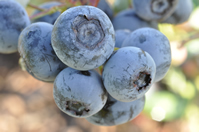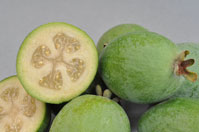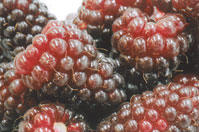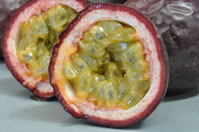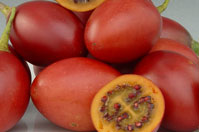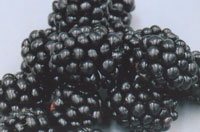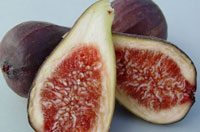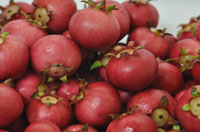
Passionfruit |
Passiflora edulis |

|
Key Points
- Generally a quick return crop.
- Requires a warm, frost-free situation.
- Needs post and wire support for vines.
- Long picking season with the main flush in autumn.
Climate
Temperature
Passionfruit love the heat so long as they are also provided with sufficient moisture for healthy growth.
Frost Tolerance
Very sensitive to frost. Even one or two degrees of frost can cause tissue damage and reduce potential cropping. Heavy frosts will decimate even well-established, mature vines.
Chill Hours
N/A
NZ climate charts
You can read more about NZ's Cold Hardiness and Climate Zone here
Wind/Shelter
Good shelter is vital as strong winds can damage flowers, fruit and vines. Estabishing live shelter belts before planting will help to filter the wind and keep the site warm as well as providing the added bonus of reduced soil moisture loss during dry spells
Sunshine Hours
Bring it on! Passionfruit love the sun.
Rainfall
The best scenario for passionfruit throughout the growing season would be adequate moisture at the roots with warm, dry foliage, flowers and fruit. Many existing blocks are not artificially irrigated, however, if passionfruit are to achieve maximum yields, they require reasonably high soil-moisture levels throughout fruit development and ripening. Where natural rainfall is insufficient to satisfy this need, irrigation may be a wise investment.
Soil Requirements
Soil Type
Passionfruit do best in a well-drained, highly fertile sandy loam with good levels of organic matter to aid moisture retention through dry periods.
Heavy, wet clays or very light, stony soils with poor moisture retention are generally unsuitable for commercial passionfruit production.Drainage
Good drainage is essential for passionfruit production as they are extremely sensitive to poor soil aeration and consequently suffer badly during prolonged periods of water-logged soil conditions. Heavy, wet clays and low-lying sites that are prone to flooding are generally unsuitable as passionfruit roots are very susceptible to fungal attack and root rots.
Spacing
The vigorous growth habit of passionfruit dictates that they are commonly trained along, and supported by, strong post and wire structures. Plant spacing within the row can be up anywhere from 2.5m to 5m depending on the chosen management regime. The distance between rows is dependant on the machinery and management practices used but is usually around 3m. Where practicable, rows should align North-South to expose both sides to plenty of sunlight.
Crop Establishment
Selecting Varieties
Our passionfruit are grown using reliable seed sources of passiflora edulis 'Black Beauty' to ensure healthy growth, maximum yield and high pulp content.
Planting Time
The preferred planting time is mid-November when the soil is warming up and the danger of excessively cold temperatures should have passed.
Cultivation
Site preparation should commence up to 12 months prior to planting time to ensure that perennial weeds are eliminated and any drainage issues are resolved. Sub-soiling should be considered to further improve drainage and encourage deeper rooting. Permanent support structures should be erected with planting strips worked to a fine tilth to provide ease of planting and to encourage rapid establishment of young plants.
Fertiliser
Any nutrient deficiencies or necessary pH adjustments indicated by the initial soil test should be corrected by incorporating suitable applications preferably at least 6 months prior to planting. Usually, if this is done, no further fertiliser needs to be added at planting time but a few handsful of Blood and Bone may be incorporated into the planting hole.
Irrigation
Irrigation may not be necessary if planting in wet conditions but during dry spells sufficient water should be applied to thoroughly wet and settle the soil immediately after planting.
Tips
Take care that the roots are protected from the sun and are never allowed to dry out. Plant firmly and make sure that the roots are lightly covered with soil but avoid burying the plants too deeply.
Crop Maintenance
Fertiliser
Passionfruit are heavy feeders and, on most soils, nutrients will need to be topped up regularly with high-nitrogen N.P.K fertiliser applications throughout the growing season. Based on orchard performance, plant appearance and the quantity of fruit harvested, soil and/or leaf testing may be required to identify specific nutrient deficiencies.
Irrigation
Maintaining adequate soil moisture levels throughout the growing season will help to minimise plant stress and maximise possible yields. Where irrigation is used, good management skills are required to achieve the balance between too little and excessive irrigation as too much water can also create problems .
Where sprinklers are used, they need to be raised above the top of the foliage to allow even distribution. Drip irrigation is suited to passionfruit production because it delivers water directly to the roots whilst leaving foliage and fruit dry but, again, careful monitoring is required to ensure that system is working efficiently and that the vines are receiving the correct amount of water while, at the same time, minimising the chances of root-rots developing because of over-watering.Pest & Disease Control
A handful of insect pests can be troublesome to passionfruit. Sap-sucking passionvine hoppers can significantly reduce yields if they are present in large numbers and mealybugs can become an unsightly pest on the fruit. The stinking green vegetable bug can cause skin blemishes on fruit and aphids may attack tender new shoots.
Some of the fungal diseases that can affect passionfruit, such as phytophthora and other root-rots manifest themselves where the drainage is inefficent and/or at times of heavy rainfall and high humidity but two of the worst, grease spot and bacterial blast, can attack at almost any time and can affect every above-ground part of the plant. Several other fungal diseases can be a problem so careful observation and early intervention is critical to ensure effective control.Good orchard managemenr and hygiene can do much to minimise the risks but the efficient control of pests and diseases is particularly crucial where markets demand completely blemish-free fruit. Most growers rely on a compehensive agri-chemical spray program for control. Whether or not to apply chemicals is a decision for the individual grower to make but here at Tharfield we use an IPM Services (2009) Ltd integrated pest management program that requires us to regularly monitor our crops, to maintain high standards of nursery hygiene and, where appropriate, to make efficient use of predator insects in order to minimise the need for chemical controls.Weed Control
Persistant perennial weeds should be eradicated prior to planting. Knock-down herbicides are usually used to control annual weeds around the plants but care must be taken to avoid contact with any part of the vines including the trunks. Things change constantly in the world of agri-chemicals so seek advice from your horticultural advisor before applying any herbicides around your crop. The shallow-rooting habit of passionfruit should be taken into consideration if manual or mechanical weeding methods are employed.
Regular mowing of grass strips is usual but over-all mechanical cultivation is sometimes used to control weeds between the rows.Bird Control
The hard shell protecting the passionfruit pulp generally keeps the birds at bay.
Pollination
Bees, honey, bumble and wild, are responsible for most of the pollination and an active bee population is needed throughout the flowering period. On rare occasions this may necessitate the introduction of hives but, as a rule, the prevailing climatic conditions at flowering time have the greatest influence on pollination efficiency. As passionfruit are self-fertile good fruit set can be expected from a single cultivar planted in isolation.
Harvest & Handling
Picking
Fruit is usually picked from the ground as it naturally ripens and drops from the vine. The problem with this is that the skin is particularly prone to sunburn at this stage and regular picking throughout the day may be needed to prevent damage to fruit in the hottest months. Fruit may be picked directly from the vine but it requires skill to judge the optimum degree of maturity.
Post Harvest
Despite having a tough outer shell, passionfruit still need handling with care to minimise unsightly skin blemishes. They usually require washing to remove dust and spray residue before being, air-dried, graded and packed to suit market requirements.
Expected Yield
Many factors can influence yields from commercial passionfruit production but a rough guide would be: 5-6 tonnes the year 2 after planting rising to 10-12 tonnes for the following 3 or 4 seasons before yields start to decline as the plants age.
More Information
- Temperate and Subtropical Fruit Production, 2nd Edition - Edited by D.I.Jackson and N.E. Looney, CABI Publishing
- IPM Services (2009) Ltd
- www.hortnet.co.nz
- www.passionfruit.org.nz
Enquiry
Please email Andrew Boylan, andrew.boylan@edible.co.nz for quotes or for any other queries you may have regarding our products and services. Minimum orders of 50 units per variety.
So that Andrew can respond to your enquiery promptly, please tell us:
- Your address (so we have some idea of your climate)
- The variety you are interested in
- The approximate numbers required
- Whether you a new grower or an established producer?
Many thanks
